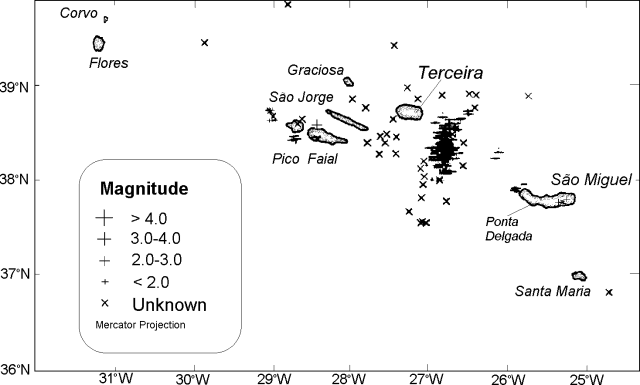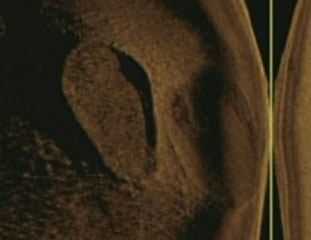Report on Don Joao de Castro Bank (Portugal) — July 1997
Bulletin of the Global Volcanism Network, vol. 22, no. 7 (July 1997)
Managing Editor: Richard Wunderman.
Don Joao de Castro Bank (Portugal) Magnitude 5.5 earthquake and associated seismic swarm
Please cite this report as:
Global Volcanism Program, 1997. Report on Don Joao de Castro Bank (Portugal) (Wunderman, R., ed.). Bulletin of the Global Volcanism Network, 22:7. Smithsonian Institution. https://doi.org/10.5479/si.GVP.BGVN199707-382070
Don Joao de Castro Bank
Portugal
38.23°N, 26.63°W; summit elev. -13 m
All times are local (unless otherwise noted)
On 27 June 1997 at 0439 a strong earthquake struck the Azores Archipelago. This main shock reached M 5.5 and was felt with maximum intensity of V on the Modified Mercalli Scale at Terceira and São Miguel islands; in the islands of São Jorge, Pico, and Faial, the respective maximum intensities were III/IV, III/IV, and II/III.
The epicenter was in the vicinity of Don João de Castro bank (figure 2), a submarine volcanic structure. An earthquake swarm began the same day. During one month about 2,000 such events were registered at a reference seismic station on São Miguel island. Approximately 45 earthquakes with M > 4 were registered at Terceira island. By 12 September about 2,100 earthquakes had occurred but by then the swarm had declined to 1 or 2 small events a day.
 |
Figure 2. Epicenters during part of the seismic swarm at the Don João de Castro bank (Azores Archipelago), 27 June to 2 August 1997. Provided by SIVISA; courtesy of J.L. Gaspar. |
In 1720 AD the Don João de Castro Bank produced an eruption with a Volcanic Explosivity Index (VEI) of 3. After four days an ephemeral, 1-km-long island was created. The area was charted in 1941. Seismic swarms in this general region were also noted in 1988 and 1989 (SEAN 13:10 and 14:03).
Geological Summary. Don Joao de Castro Bank is a large submarine volcano that rises to within 13 m of the ocean surface roughly halfway between Terceira and San Miguel Islands. Pillow lavas form the base of the volcano, which is capped by basaltic hyaloclastites. A submarine eruption during December 1720 produced an ephemeral island that attained a length of 1.5 km and a height of about 250 m before it was eroded beneath the surface two years later. The volcano (also spelled Dom Joao de Castro) was named after the Portuguese hydrographic survey vessel that surveyed the bank in 1941. Two youthful craters, one tephra covered and the other sediment free, are located on the NW flank. The submarine volcano has a shallow fumarole field and remains seismically active.
Information Contacts: Azores Seismological Surveillance System (SIVISA), coordinated by a)J.L. Gaspar, Azores University Centre of Volcanology, 9500 - Ponta Delgada, Azores, Portugal and b)Luísa Senos, Meteorological Institute, 9500 Ponta Delgada, Azores, Portugal.

